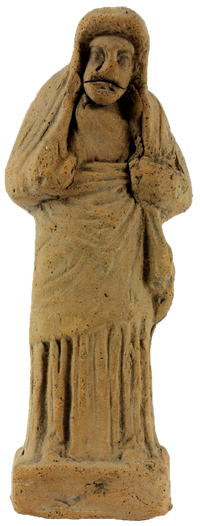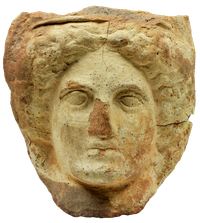Terracottas from Campania
 |
 |
 |
 |
 |
|
Campania stretches along the coast of the Tyrrhenian Sea between Latium and Lucania (today's Basilicata). It was already a melting pot of different peoples in the first half of the 1st millennium BC. Greek settlers, who settled there from the 2nd quarter of the 8th century BC, met indigenous peoples (natives) with local cultural traditions and different Italic languages. Above all, the Samnites and the Lucanians, who were related to them, achieved greater importance. From the 7th century BC, the inhabitants of Campania came under the influence of the Etruscans, who increasingly controlled the land east of the Greek colonies on the Gulf of Naples down to Paestum. The most important Etruscan city in this region was the rich, powerful Capua[1].
In 474 BC, Etruscan supremacy ended in a naval battle against the Greeks at Kyme. A little later, Samnite tribes occupied Capua and Nola, Pompeii and Herculaneum, then also Greek Kyme (Cumae). In 400 BC, the likewise Greek Poseidonia became the Lucanian Paestum[2].
Enlivened by the diverse cultural influences, the terracotta sculpture of Campania developed in two different directions. One, mediated by the neighbourhood of Sicily and Magna Graecia, is entirely in the Greek tradition. Even the products remodelled in the taste of local coroplastic centres usually still reveal Greek models[3]. The other direction clearly sets itself apart from any "classical" form and goes its own way[4].
The following five terracottas in the Giessen collection are characterised not only by Greek art but also by a certain intellectual and artistic independence.
[1]„ Urbs maxima opulentissimaque Italiae“, Titus Livius VII, 31, I; M. Bonghi Jovino, Terrecotte votive. Catalogo del Museo provinciale campano I (Florenz 1965) 13; M. Torelli, Die Etrusker. Geschichte, Kultur, Gesellschaft (Wiesbaden 1998) 49. 211.
[2] The 4th century BC was marked by the Samnite conflicts with expanding Rome, which sealed its power over Campania in the peace treaty of 304 BC., M. Frederiksen, Campania (Oxford 1984) 1-4 and 99 f.; P. G. Guzzo – S. Moscati – G. Susini (eds.), Antiche genti d’Italia (Rom 1995), 13; T. Fischer-Hansen, Catalogue Campania, South Italy and Sicily Ny Carlsberg Glyptotek (Kopenhagen 1992) 9; F.-K. Kienitz, Völker im Schatten. Die Gegenspieler der Griechen und Römer (München 1981); G. Pugliese Carratelli (ed.), I Greci in Occidente (Mailand 1996), 117. 145.
[3] In Hellenistic times, artistic production was increasingly subject to flattening, B. Grassi, La scultura in argilla, in: S. Cassani – V. Sampaolo (Hrsg.), Il Museo Archeologico dell’ Antica Capua (Neapel 1995), 38.
[4] S. Ciaghi, Le Terrecotte figurate da Cales del Museo Nazionale di Napoli (Rom 1993) 253 f. fig. 180; W. Wamser-Krasznai, Lepra im Alten Italien??? Glossen zur Ikonodiagnostik antiker Bildwerke, im Druck. Examples of the three directions s. two votive heads after portraits of Alexander, Bonghi Jovino ibid. 1965, 119 pl. 56, 2 and 119 f. pld. 56, 3 and 4. The third is supported by examples ibid. p. 27 pl. 1,1. p. 30 pl. 5, 3. p. 40 pl. 9,4. p. 40 and 43 pl. 10. p. 51 pl. 17, 3.
